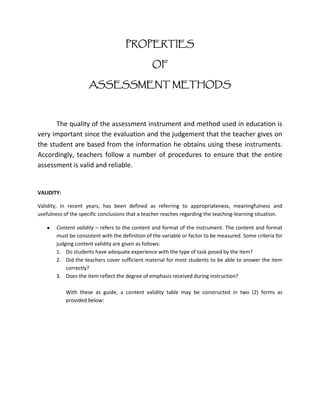Properties of Assessment Methods
•Download as DOCX, PDF•
8 likes•16,223 views
Report
Share
Report
Share

Recommended
Recommended
More Related Content
What's hot
What's hot (20)
Performance-Based Assessment (Assessment of Learning 2, Chapter 2))

Performance-Based Assessment (Assessment of Learning 2, Chapter 2))
PORTFOLIO/PRODUCT/PROCESS ORIENTED PERFORMANCE-BASED ASSESSMENT, Ed8

PORTFOLIO/PRODUCT/PROCESS ORIENTED PERFORMANCE-BASED ASSESSMENT, Ed8
Professional Education reviewer for PRC-LET or BLEPT Examination

Professional Education reviewer for PRC-LET or BLEPT Examination
Viewers also liked
Viewers also liked (20)
The roles of stakeholders in curriculum implementation

The roles of stakeholders in curriculum implementation
Guiding Principles for the Assessment of Student Learning

Guiding Principles for the Assessment of Student Learning
Using assessment data for improving teaching practice acer conference 2009 ppt

Using assessment data for improving teaching practice acer conference 2009 ppt
58519966 review-of-principles-of-high-quality-assessment

58519966 review-of-principles-of-high-quality-assessment
Educational measurement, assessment and evaluation

Educational measurement, assessment and evaluation
Similar to Properties of Assessment Methods
Similar to Properties of Assessment Methods (20)
Principlesofhighqualityassessment 121028212944-phpapp02 (1)

Principlesofhighqualityassessment 121028212944-phpapp02 (1)
Validity, reliabiltiy and alignment to determine the effectiveness of assessment

Validity, reliabiltiy and alignment to determine the effectiveness of assessment
Concept and nature of measurment and evaluation (1)

Concept and nature of measurment and evaluation (1)
More from Monica Angeles
More from Monica Angeles (8)
Recently uploaded
Recently uploaded (20)
Kodo Millet PPT made by Ghanshyam bairwa college of Agriculture kumher bhara...

Kodo Millet PPT made by Ghanshyam bairwa college of Agriculture kumher bhara...
Plant propagation: Sexual and Asexual propapagation.pptx

Plant propagation: Sexual and Asexual propapagation.pptx
General Principles of Intellectual Property: Concepts of Intellectual Proper...

General Principles of Intellectual Property: Concepts of Intellectual Proper...
ICT Role in 21st Century Education & its Challenges.pptx

ICT Role in 21st Century Education & its Challenges.pptx
Basic Civil Engineering first year Notes- Chapter 4 Building.pptx

Basic Civil Engineering first year Notes- Chapter 4 Building.pptx
HMCS Max Bernays Pre-Deployment Brief (May 2024).pptx

HMCS Max Bernays Pre-Deployment Brief (May 2024).pptx
Jual Obat Aborsi Hongkong ( Asli No.1 ) 085657271886 Obat Penggugur Kandungan...

Jual Obat Aborsi Hongkong ( Asli No.1 ) 085657271886 Obat Penggugur Kandungan...
Properties of Assessment Methods
- 1. PROPERTIES OF ASSESSMENT METHODS The quality of the assessment instrument and method used in education is very important since the evaluation and the judgement that the teacher gives on the student are based from the information he obtains using these instruments. Accordingly, teachers follow a number of procedures to ensure that the entire assessment is valid and reliable. VALIDITY: Validity, in recent years, has been defined as referring to appropriateness, meaningfulness and usefulness of the specific conclusions that a teacher reaches regarding the teaching-learning situation. Content validity – refers to the content and format of the instrument. The content and format must be consistent with the definition of the variable or factor to be measured. Some criteria for judging content validity are given as follows: 1. Do students have adequate experience with the type of task posed by the item? 2. Did the teachers cover sufficient material for most students to be able to answer the item correctly? 3. Does the item reflect the degree of emphasis received during instruction? With these as guide, a content validity table may be constructed in two (2) forms as provided below:
- 2. FORM A: Item Validity CRITERIA ITEM NUMBER 1 2 3 4 5 6 1. Material covered sufficiently 2. Most students are able to answer item correctly 3. Students have prior experience with the type of task 4. Decision: accept or reject FOM B: Entire Test Knowledge/Skills Area Estimated Percent of Percentage of Items Instruction Covered in Test 1. Knowledge 2. Comprehension 3. Application 4. Analysis 5. Synthesis 6. Evaluation Face Validity – refers to the outward appearance of the test Criterion-related validity – the test item is judged against a specific criterion, e.g. relevance to the topic on conservation. It can also be measured by correlating the test with a known valid test Construct validity - A technique called factor analysis is required to determine the construct validity of an item. RELIABILITY: The reliability of an assessment method refers to its consistency. It is also a term synonymous with dependability or stability. Stability or internal consistency as reliability measures can be estimated in several ways; Spearman-Brown prophecy formula: Reliability of test = (2 x rhalf) / (1 + rhalf) Where: rhalf = reliability of the half of the test Kuder-Ricahrdson: KR21 = K/ (K-1) [1 – {n (K-M)} / K (Variance)]
- 3. Where: K = number of items on the test M= mean of the test Variance = variance of the test scores Reliability of a test may also mean consistency of test results when the same test is administered at two different time periods. This is the test-retest method estimating reliability. The estimate of test reliability is then given by the correlation of the two test result. FAIRNESS: An assessment procedure needs to be fair. This means: Students need to know exactly what the learning targets are and what method of assessment will be used. Assessment has to be viewed as an opportunity to learn. Fairness also implies freedom from teacher-stereotyping. PRACTICALITY AND EFFICIENCY: An assessment method should be practical in the sense that the teacher should be familiar with it, does not require too much time and is in fact, implementable. A complex assessment procedure tends to be difficult to score and interpret resulting in a lot misdiagnosis or too long a feedback period which may render the test inefficient. ETHICS IN ASSESSMENT: Here are some situations in which assessment may not be called for: Requiring students to answer checklist of their sexual fantasies Asking elementary pupils to answer sensitive questions without the consent of their parents Testing mental abilities of pupils using an instrument whose validity and reliability are unknown.
